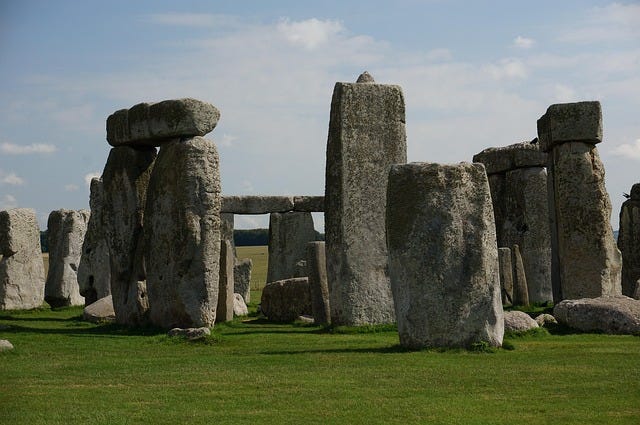Inside Salisbury: Spiritual celebration looms at Stonehenge but how much do you know about this monument?
Stonehenge and how to celebrate the summer solstice
A SPIRITUAL celebration that draws thousands of people from all across the world to mark the end of spring is to take place this week.
Stonehenge is an archaeological site which has stood the test of time, and thousands of people each year attend the summer solstice. The word solstice comes from the Latin words e.g. Sol (sun) and Sistere (to stand), and the event celebrates the first glimpse of the sun’s rays through the ancient stones.
The summer solstice heralds the longest day of the year, and this is when the Earth’s northern hemisphere is at its most tilted position towards the sun. It is the time when the position of the sun, whether rising or setting, stands still as it progresses along the horizon. It is the longest day of the year, and the shortest night.
Celebrating the solstice
This year, the Summer Solstice occurs on June 21 at 03.42 BST, but to celebrate the stones, it is important to understand the monument’s history.
It is known that spirituality lies at the heart of the monument, and this has been a central part of it since its construction. Today, the site is revered for its history, for its rituals and ceremonies, as well as its intrigue.
The building of Stonehenge began about 5,000 years ago during the Neolithic period. By 2500 BC, larger stones had been placed marking the moment when 800 years of building began. The work continued into the Bronze Age.
Many theories have been suggested over the years about the purpose of Stonehenge. But what does the evidence suggest?
It is known that approximately 6,000 years ago, farming communities began to arrive from Europe, and monuments were built for ritual and gathering.
According to English Heritage, mesolithic posts (totem poles) were raised by hunter-gatherers, and these were placed in the north-west of the site.
The sarsen stones were erected in the centre of the site in about 2,500 BC. These were placed carefully to line up with the movement of the sun. On Midsummer’s Day, the sun rises to the left of the Heel Stone (located north-east of the circle). A large stone hole to the left of the Heel Stone may have held a second stone, and in which case, this would have framed the sun as it rose.
The origin of the stones
More than 80 large sarsen stones were taken from the Marlborough Downs, 15 miles away, and placed in the centre in two concentric arrangements. This would have taken many years to complete. The sarsen stones, which weighed approximately 25 tonnes, are formed from silicified sandstone.
For the stones to be moved, it would have taken considerable strength and more than a little ingenuity. The stones were raised using joints which would be found typically in woodworking. These joints are not noted at other prehistoric monuments.
The smaller bluestones were transported from the Preseli Hills in Wales, a distance of approximately 150 miles. But Stonehenge may have been more collaborative than originally thought, as the six-tonne altar stone originated from the far north of Scotland - a distance of 434 miles.
A late monument from the Neolithic period, known as the Avenue also linked Stonehenge to the River Avon. It was made from ditches and parallel banks, and it too was linked to the movement of the sun.
Calendar
According to English Heritage, there are few clues to indicate why Stonehenge was built. However, excavations suggest that the stone circle was kept clean from any debris, so it is believed that people attended to celebrate midsummer and midwinter.
Stonehenge is likely to have been more than a calendar, enabling people to worship a solar deity or to remember those who had died. But it is important to consider that the builders were farmers, herders and pastoralists and they would have worked with the seasons in terms of what they could grow and when while spirituality was also key.
For those who are hoping to attend this year’s Summer Solstice, it is advisable to wear sensible footwear and take layers of clothes if staying overnight. The car park is open on Friday, June 20, from 7 pm with access to the Stonehenge Monument Field. Sunset will take place at 9.26 pm.
On Saturday, June 21, the monument field closes at 8 am. The car park must be vacated by noon.
For those who are unable to attend, a livestream will be available from the evening of June 20 to the sunrise on June 21. This is free on English Heritage channels.
Visitors to Stonehenge encouraged to leave their cars at home for the Summer Solstice
FOR those wishing to attend the Summer Solstice at Stonehenge this weekend, English Heritage is encouraging people to leave their cars at home and to use sustainable transport.
Salisbury Reds is providing a special 333 bus to take people to the stones well into the night and to bring people back from sunrise.
Salisbury Reds General Manager, Andrew Sherrington, said: “We are expecting high volumes of people and we’ll be running services from Salisbury throughout Friday evening from 6.30 pm right up until 1 am on Saturday. Then we’ll start to take people back from 4 am until 10 am with stops along the way.
“Working closely with English Heritage at Stonehenge, we already provide a special bus service to the location - for anyone wishing to leave their cars behind. But Summer Solstice is an extraordinary event that draws many visitors throughout the night each year.
This shuttle service leaves New Canal stand U, stopping at Salisbury train station and Amesbury along the way, before arriving at Stonehenge.
“The aim is to make it as easy as possible for people to come and experience the magical atmosphere here, without having to worry about how they will get home. Using sustainable transport means they get to help the environment at the same time.”
Tickets for the special Solstice service are available to buy via the Salisbury Reds app or from the driver. Those choosing to purchase tickets in advance on the app can enjoy a discounted rate.
For more information about the shuttle service, its timetable and fares, visit Salisbury Reds website.
.






